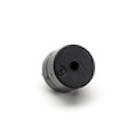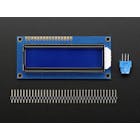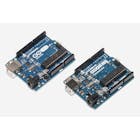//This code is to use with DS1302 RTC module + 4*4 Keypad + LCD i2c + Arduino + Buzzer
//After wiring the modules, the LCD will show the default date and time or the one set before
//The objective of this project is that you can set the RTC module from the keypad, and sure it will stay stored
//Then show it on the screen and after you can set your alarm.
//Refer to Surtrtech.com or SurtrTech youtube channel for more information
#include <Keypad.h> //Libraries needed
#include <Wire.h>
#include <virtuabotixRTC.h>
#include <LiquidCrystal_I2C.h>
#define I2C_ADDR 0x27 //LCD i2c stuff
#define BACKLIGHT_PIN 3
#define En_pin 2
#define Rw_pin 1
#define Rs_pin 0
#define D4_pin 4
#define D5_pin 5
#define D6_pin 6
#define D7_pin 7
LiquidCrystal_I2C lcd(I2C_ADDR,En_pin,Rw_pin,Rs_pin,D4_pin,D5_pin,D6_pin,D7_pin);
virtuabotixRTC myRTC(2, 3, 4); //Wiring of the RTC (CLK,DAT,RST)
//If you change the wiring change the pins here also
const byte numRows= 4; //number of rows on the keypad
const byte numCols= 4; //number of columns on the keypad
//keymap defines the key pressed according to the row and columns just as appears on the keypad
char keymap[numRows][numCols]=
{
{'1', '2', '3', 'A'},
{'4', '5', '6', 'B'},
{'7', '8', '9', 'C'},
{'*', '0', '#', 'D'}
};
byte rowPins[numRows] = {12,11,10,9}; //Rows 0 to 3 //if you modify your pins you should modify this too
byte colPins[numCols]= {8,7,6,5}; //Columns 0 to 3
int i1,i2,i3,i4;
char c1,c2,c3,c4;
char keypressed,keypressedx;
int A_hour=NULL;
int A_minute=NULL;
int AlarmIsActive=NULL;
int buzzer = 13;
Keypad myKeypad= Keypad(makeKeymap(keymap), rowPins, colPins, numRows, numCols);
void setup() {
Serial.begin(9600);
lcd.begin (16,2); //Initialize the LCD
lcd.setBacklightPin(BACKLIGHT_PIN,POSITIVE);
lcd.setBacklight(HIGH);
lcd.home ();
}
void loop() {
while(keypressed == NO_KEY){ //As long as no key is pressed we keep showing the date and time, I'm obliged to clear the screen everytime so the numbers don't get confused
//And I should add that little delay so the screen shows correctly otherwise it didn't work for me
keypressed = myKeypad.getKey();
lcd.clear(); //Here after clearing the LCD we take the time from the module and print it on the screen with usual LCD functions
myRTC.updateTime();
if(myRTC.hours==A_hour && myRTC.minutes==A_minute && AlarmIsActive==1 && myRTC.seconds >= 0 && myRTC.seconds <= 2){
while(keypressedx == NO_KEY){
tone(buzzer, 1000); //You can modify the tone or make your own sound
delay(100);
tone(buzzer, 2000);
delay(100);
lcd.clear();
lcd.print("Get up !!!"); //Message to show when the alarm is ringing
keypressedx = myKeypad.getKey();
}
}
keypressedx = NO_KEY;
noTone(buzzer);
lcd.setCursor(0,0);
lcd.print(myRTC.dayofmonth);
lcd.print("/");
lcd.print(myRTC.month);
lcd.print("/");
lcd.print(myRTC.year);
lcd.setCursor(0,1);
lcd.print(myRTC.hours);
lcd.print(":");
lcd.print(myRTC.minutes);
lcd.print(":");
lcd.print(myRTC.seconds);
delay(100);
}
if (keypressed == '*') //As we everytime check the key pressed we only proceed to setup if we press "*"
{
lcd.clear();
lcd.print(" Setup");
delay(1000);
lcd.clear();
lcd.print("Setup year");
//So you can understand how this works, first it shows us "setup" then it prints "setup year" and now you can write your year normally (2-0-1-8)
//It automatically passes to setting up the month...until it's finished
//The keys from keypad are all considered chars (c) so we should convert them to int that's what I did then we store them (i)
//We do some math and we get the year, month... as int so we can inject them to the RTC otherwise it will not be compiled
//Months like April you should write 04, 03 for March... otherwise it will not pass to the next parameter
//The RTC virtuabotix library is already set to not accept strange time and dates (45/17/1990) (58:90:70), and yes old dates are considered as errors
char keypressed2 = myKeypad.waitForKey();
if (keypressed2 != NO_KEY && keypressed2 !='*' && keypressed2 !='#' && keypressed2 !='A' && keypressed2 !='B' && keypressed2 !='C' && keypressed2 !='D' )
{
c1 = keypressed2;
lcd.setCursor(0, 1);
lcd.print(c1);
}
char keypressed3 = myKeypad.waitForKey();
if (keypressed3 != NO_KEY && keypressed3 !='*' && keypressed3 !='#' && keypressed3 !='A' && keypressed3 !='B' && keypressed3 !='C' && keypressed3 !='D' )
{
c2 = keypressed3;
lcd.setCursor(1, 1);
lcd.print(c2);
}
char keypressed4 = myKeypad.waitForKey();
if (keypressed4 != NO_KEY && keypressed4 !='*' && keypressed4 !='#' && keypressed4 !='A' && keypressed4 !='B' && keypressed4 !='C' && keypressed4 !='D' )
{
c3 = keypressed4;
lcd.setCursor(2, 1);
lcd.print(c3);
}
char keypressed5 = myKeypad.waitForKey();
if (keypressed5 != NO_KEY && keypressed5 !='*' && keypressed5 !='#' && keypressed5 !='A' && keypressed5 !='B' && keypressed5 !='C' && keypressed5 !='D' )
{
c4 = keypressed5;
lcd.setCursor(3, 1);
lcd.print(c4);
}
i1=(c1-48)*1000; //the keys pressed are stored into chars I convert them to int then i did some multiplication to get the code as an int of xxxx
i2=(c2-48)*100;
i3=(c3-48)*10;
i4=c4-48;
int N_year=i1+i2+i3+i4;
delay(500);
lcd.clear();
lcd.print("Setup month");
////////////////////////////////////////////////////////////////
char keypressed6 = myKeypad.waitForKey(); // here all programs are stopped until you enter the four digits then it gets compared to the code above
if (keypressed6 != NO_KEY && keypressed6 !='*' && keypressed6 !='#' && keypressed6 !='A' && keypressed6 !='B' && keypressed6 !='C' && keypressed6 !='D' )
{
c1 = keypressed6;
lcd.setCursor(0, 1);
lcd.print(c1);
}
char keypressed7 = myKeypad.waitForKey();
if (keypressed7 != NO_KEY && keypressed7 !='*' && keypressed7 !='#' && keypressed7 !='A' && keypressed7 !='B' && keypressed7 !='C' && keypressed7 !='D' )
{
c2 = keypressed7;
lcd.setCursor(1, 1);
lcd.print(c2);
}
i1=(c1-48)*10;
i2=c2-48;
int N_month=i1+i2;
delay(500);
lcd.clear();
lcd.print("Setup Day");
////////////////////////////////////////////////////////////////
char keypressed8 = myKeypad.waitForKey(); // here all programs are stopped until you enter the four digits then it gets compared to the code above
if (keypressed8 != NO_KEY && keypressed8 !='*' && keypressed8 !='#' && keypressed8 !='A' && keypressed8 !='B' && keypressed8 !='C' && keypressed8 !='D' )
{
c1 = keypressed8;
lcd.setCursor(0, 1);
lcd.print(c1);
}
char keypressed9 = myKeypad.waitForKey();
if (keypressed9 != NO_KEY && keypressed9 !='*' && keypressed9 !='#' && keypressed9 !='A' && keypressed9 !='B' && keypressed9 !='C' && keypressed9 !='D' )
{
c2 = keypressed9;
lcd.setCursor(1, 1);
lcd.print(c2);
}
i1=(c1-48)*10;
i2=c2-48;
int N_day=i1+i2;
delay(500);
lcd.clear();
lcd.print("Setup hour");
////////////////////////////////////////////////////////////////////////////////////:
char keypressed10 = myKeypad.waitForKey(); // here all programs are stopped until you enter the four digits then it gets compared to the code above
if (keypressed10 != NO_KEY && keypressed10 !='*' && keypressed10 !='#' && keypressed10 !='A' && keypressed10 !='B' && keypressed10 !='C' && keypressed10 !='D' )
{
c1 = keypressed10;
lcd.setCursor(0, 1);
lcd.print(c1);
}
char keypressed11 = myKeypad.waitForKey();
if (keypressed11 != NO_KEY && keypressed11 !='*' && keypressed11 !='#' && keypressed11 !='A' && keypressed11 !='B' && keypressed11 !='C' && keypressed11 !='D' )
{
c2 = keypressed11;
lcd.setCursor(1, 1);
lcd.print(c2);
}
i1=(c1-48)*10;
i2=c2-48;
int N_hour=i1+i2;
delay(500);
lcd.clear();
lcd.print("Setup minutes");
////////////////////////////////////////////////////////////////////////////////////:
char keypressed12 = myKeypad.waitForKey(); // here all programs are stopped until you enter the four digits then it gets compared to the code above
if (keypressed12 != NO_KEY && keypressed12 !='*' && keypressed12 !='#' && keypressed12 !='A' && keypressed12 !='B' && keypressed12 !='C' && keypressed12 !='D' )
{
c1 = keypressed12;
lcd.setCursor(0, 1);
lcd.print(c1);
}
char keypressed13 = myKeypad.waitForKey();
if (keypressed13 != NO_KEY && keypressed13 !='*' && keypressed13 !='#' && keypressed13 !='A' && keypressed13 !='B' && keypressed13 !='C' && keypressed13 !='D' )
{
c2 = keypressed13;
lcd.setCursor(1, 1);
lcd.print(c2);
}
i1=(c1-48)*10;
i2=c2-48;
int N_minutes=i1+i2;
delay(500);
lcd.clear();
myRTC.setDS1302Time(22, N_minutes, N_hour, 1, N_day, N_month, N_year); //once we're done setting the date and time we transfer to values to the RTC module
//the 22 stands for seconds you can add a setup for it too if you want
//the 1 stands for day of the week, as long I don't show it on the screen I don't change it
keypressed=NO_KEY; //the "*" key is stored in "keypressed" so I remove that value from it otherwise it will get me in the setup again
}
/////////////////////////////////////////Alarme setup/////////////////////////////////
if (keypressed == 'A'){
lcd.clear();
lcd.print(" Alarm setup ");
delay(1000);
lcd.clear();
lcd.print("Set alarm hour");
char keypressed14 = myKeypad.waitForKey(); // here all programs are stopped until you enter the four digits then it gets compared to the code above
if (keypressed14 != NO_KEY && keypressed14 !='*' && keypressed14 !='#' && keypressed14 !='A' && keypressed14 !='B' && keypressed14 !='C' && keypressed14 !='D' )
{
c1 = keypressed14;
lcd.setCursor(0, 1);
lcd.print(c1);
}
char keypressed15 = myKeypad.waitForKey();
if (keypressed15 != NO_KEY && keypressed15 !='*' && keypressed15 !='#' && keypressed15 !='A' && keypressed15 !='B' && keypressed15 !='C' && keypressed15 !='D' )
{
c2 = keypressed15;
lcd.setCursor(1, 1);
lcd.print(c2);
}
i1=(c1-48)*10;
i2=c2-48;
A_hour=i1+i2;
delay(500);
lcd.clear();
lcd.print("Set alarm minutes");
char keypressed16 = myKeypad.waitForKey(); // here all programs are stopped until you enter the four digits then it gets compared to the code above
if (keypressed16 != NO_KEY && keypressed16 !='*' && keypressed16 !='#' && keypressed16 !='A' && keypressed16 !='B' && keypressed16 !='C' && keypressed16 !='D' )
{
c1 = keypressed16;
lcd.setCursor(0, 1);
lcd.print(c1);
}
char keypressed17 = myKeypad.waitForKey();
if (keypressed17 != NO_KEY && keypressed17 !='*' && keypressed17 !='#' && keypressed17 !='A' && keypressed17 !='B' && keypressed17 !='C' && keypressed17 !='D' )
{
c2 = keypressed17;
lcd.setCursor(1, 1);
lcd.print(c2);
}
i1=(c1-48)*10;
i2=c2-48;
A_minute=i1+i2;
delay(500);
lcd.clear();
AlarmIsActive=1;
keypressed=NO_KEY;
}
if (keypressed == 'B')
{
lcd.clear();
lcd.print("Alarm deactivated");
AlarmIsActive=0;
keypressed=NO_KEY;
delay(500);
}
else {
myRTC.updateTime();
keypressed=NO_KEY;
}
}







(Majors changes made 12/04/18 to solve some issues)